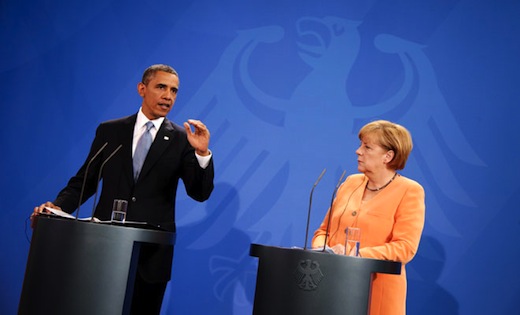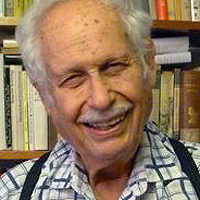
BERLIN – Although Germany has had a resurgence of neo-Nazi attacks on refugees, U.S.-Germany relations have garnered much media attention with a possible U.S. attack on Syria and the National Security Agency spying scandal.
Revelations about NSA spying on German mail, telephone and email connections galvanized protests and unleashed controversy between a double-talking chancellor, Angela Merkel, trying to avoid any position, and her very righteous-sounding Social-Democratic and Green opponents, who were themselves closely involved in German-U.S. agreements on the matter. In Berlin nearly 15,000 people demonstrated angrily against both German and U.S. spying.
But now for much of the media, the war in Syria has become dominant (though, for some, key events like the birth and name of the Windsor baby always took first place). More than two-thirds of all Germans opposed involvement in another war even before the troops came home from the one in Afghanistan.
The peace movement organized “No War against Syria” rallies in cities across Germany on September 1 – usually commemorated as Peace Day to mark the date when Germany invaded Poland and started World War II. In Berlin, at Brandenburg Gate, protesters gathered as close as permitted to the U.S. embassy. Partly because of haste in preparation, their numbers were limited to about 800 stalwarts from the Left Party, smaller parties further to the left, and some Syrians – with varying views on Assad but all opposed to Obama’s threatened air attack.
Few candidates for the Bundestag election supported Obama on Syria – except for the most important one, Chancellor Angela Merkel, who was ambiguous at first but then moved toward support of Germany’s Washington ally. She was evidently confident enough of her own personal popularity to swerve in this question, judging that the electorate’s main interest again centered on the number of 100 euro bills in its wallet or digits in its bank account while apprehensive of worrying changes.
It is possible that the long-time stress of the Left on peace, also against an attack on Syrian targets, has led to its small but possibly vital increase in the polls.
September 22 elections
As usual most media tried to turn the election into a personal confrontation between Merkel, with her homespun oratorical style and a record of averting economic catastrophe, and the Social Democrat Peer Steinbrück, who kept trying to sound witty and twist a smile onto his lemon-sour lips. But somehow, in the one TV-debate with Steinbrück, her charm was not quite so convincing while he was well prepared with facts on jobless, part-time, low-wage blots on her rosy mural. By many accounts it ended in a draw, with her necklace — gems in the national colors of red, black and gold — drawing as much attention as anything else.
But elections here are not personal duels. Becoming chancellor means winning enough seats in the Bundestag to gain a majority and form a government. With one brief exception (1960-61) one party has never managed this alone; at least one partner is always needed. If Merkel’s present partner, the big-business Free Democrats (FDP), fails to win the 5 percent of all votes needed to get into the Bundestag (it is now vacillating between 4 and 6 percent) it is then out in the cold while Merkel’s “Christians” would be stuck with about 40 percent and need to choose another partner to stay in power. The only ones available are the Greens – highly improbable – or the Social Democrats – definitely possible.
But there is one other possibility. With the Social Democrats now at 25 percent, their friends and allies the Greens at 10 or 11 percent, they cannot win. But if you add on the Left (Die Linke), now at 9 percent, and maybe another point or two here or there, that might just add up to a winning combination. The Social Democrats and Greens still insist they would never, never, never join hands with the Left, but some think they are saying it less often and less vociferously, and victory, with cabinet seats in a nice new government could prove very tempting.
Would the Left agree if offered this chance – and a Cabinet seat or two? And what about not being in the coalition, but simply “tolerating” it – voting with it without joining it, which would give it the power of choosing thumbs up or down whenever it approves or disapproves?
These matters are being hotly debated – mostly behind closed doors. Some Left leaders say “maybe” – if certain principles are maintained – like better wages and pensions and no foreign engagements. All this has given the elections a certain element of suspense after all.
However, all summer the threat of violence was in the air in Hellersdorf. This borough on the outskirts of East Berlin, once a huge site of modern high-rise buildings aimed at solving East German housing problems, provided homes for nearly 130,000 people. After “the Wall went down” many high-rise buildings were cropped from eleven to five or six stories, renovated and given colorful new facades.
But with the new problem of joblessness (currently at 11.7 percent in Berlin), more and more people left to hunt work in other parts of Germany or elsewhere. Many buildings constructed in the 1980s emptied out. More recently, working class families, some with immigrant background, after being pushed out of central Berlin by high-priced gentrification, found that rents were not soaring quite so quickly in out-lying areas like Hellersdorf. A new mix, often featuring disintegration, defeatism, sometimes a lack of hope, offered just the ingredients neo-Nazis and their allies were looking for.
Since schools and kindergartens were still in oversupply the city decided to move about 200 asylum seekers from Afghanistan, Syria and other countries into one school in Hellersdorf, transforming it into a dormitory. But ultra-rightists, smelling a chance to win votes in the approaching German elections, quickly stepped up their normal campaign of fear about imminent dangers from “foreigners,” adding the additional complaint that local residents had not been consulted in advance about the planned move.
When an open-air meeting was then arranged to explain the measure almost a thousand people showed up. But tough-looking men from the National Democratic Party (NPD) seized the microphone and soon created a truly pogrom-like atmosphere. They were joined by equally rough-looking adherents of the new Pro-Deutschland Party, whose main platform plank is bashing foreigners. All other parties spoke up against them, and soon there was a day-and-night vigil of people, mostly Left Party members and Autonomists (anarchistic-leaning anti-fascists), to oppose the fascists and protect and welcome the first few asylum-seekers, with the police trying to keep the two groups apart.
There was some minor violence, which became front-page news all over Germany, and some asylum-seekers, temporarily quartered elsewhere in the city, refused to move to Hellersdorf for fear of attacks. The situation slowly cooled down as it turned out that many or most of the local population were by no means so “anti-foreigner” as the neo-Nazis tried to portray.
Berlin’s opposition parties – the Left, the Pirates and the Greens – demanded that immigrants no longer be placed in big dormitories but be scattered instead in normal apartments around the city. This subject was part of an on-going countrywide debate about and struggle against strict restrictions on asylum-seekers in terms of freedom of movement and the right to hold a job.
Regarding the far right and other minor parties, the Sept. 22 elections seem like a long shot. Like the neo-Nazis in the NPD, mentioned above – with little chance of getting more than 2 or 3 percent nationally, especially since their new anti-foreigner rivals, the Pro-Deutschland party will split their vote. Another new party, the Alternative for Deutschland, stresses its opposition to the euro. “Back to the German mark,” it demands, with an undertone of disdain for those poor, bankrupt failure countries in southern Europe. It now stands at 2-3 percent but could show more strength when the chips – or ballots – are down. As for the Pirates, once exciting youthful fighters for Internet freedom and participation, their internecine quarrels have kept them down to a disappointing 3 percent. But who knows?
Actually there are 34 parties, far right, far left, religious, vegan and just plain nutty. Since the media, though full of commentaries, interviews and talk shows, do not permit paid campaign ads, they all make up for it by filling the streets with billboards and thousands of smaller posters attached to lampposts, often with the face of a candidate and a short slogan like Merkel’s “Successful together – for Germany” or the Social Democrats’ “The WE makes the difference.” The Greens try to be very original; one sign has a face upside down and the words, also upside down, saying: “We see things differently. And You?” The NPD has kept to its racist traditions, this year mostly against Roma and Sinti (“Gypsies”), and have been legally challenged here and there. The Left posters are most demanding: “Enough blathering: 10 Euro Minimum Wage” – “Instead of Bottle Deposits, a 1050 Euro Pension” – “Divvying Up Is Fun; Tax the Millionaires” and “Forbid Weapons Export; End Military Deployments.”
Germans will soon vote by marking their Xs by hand, never electronically, one vote for a local candidate, one vote for a preferred party. Until then nearly all decisions on domestic, European or world issues have been turned to “Wait.” It is possible that a new right or center government could really get far tougher with its own working people and with those in the rest of the continent. September 22 could well be a very decisive date for many millions of people.
Photo: In this June 19, 2013, photo U.S. President Barack Obama addresses a joint press conference with German Chancellor Angela Merkel in Berlin. Merkel, publicly questioned the legitimacy of U.S. NSA surveillance programs, while standing next to Obama during his Berlin visit. European approval for his administration’s international policies has dropped dramatically. (AP/Michael Sohn)










